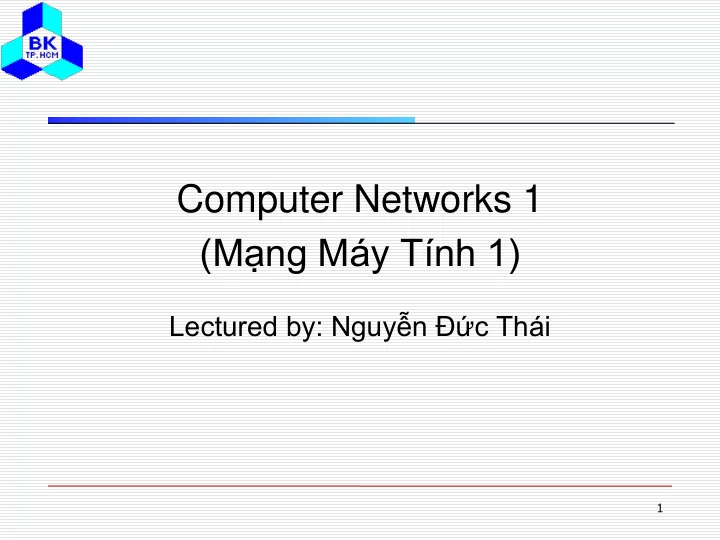

Computer Networks 1 (Mạng Máy Tính 1) Lectured by: Nguyễn Đức Thái 1
Lecture 5: Network Layer (cont’) Reference : Chapter 5 - “ Computer Networks ”, Andrew S. Tanenbaum, 4th Edition, Prentice Hall, 2003. 2
Contents The network layer design issues Routing algorithms Congestion control algorithms Quality of services Internetworking The network layer in the Internet 3
Congestion Control Algorithms General Principles of Congestion Control • Congestion Prevention Policies • Congestion Control in Virtual-Circuit Subnets • Congestion Control in Datagram Subnets • Load Shedding • Jitter Control • 4
Network Congestion When too much traffic is offered, congestion sets in and performance degrades sharply. 5
General Principles of Congestion Control Open loop solutions Solve the problems by good design Prevent congestions from happening Make decision without regard to state of the network Closed loop solutions Using feedback loop 6
Closed Loop Solutions – Three Part Feedback Loop Monitor the system detect when and where congestion occurs. Pass information to where action can be taken. Adjust system operation to correct the problem. 7
Open Loop Solutions - Congestion Prevention Policies Policies that affect congestion. 8
Congestion Control in Virtual-Circuit Subnets (a) A congested subnet. (b) A redrawn subnet, eliminates congestion and a virtual circuit from A to B. 9
Congestion Control in Datagram Subnets Warning bit Routers use a bit in the packet’s header to signal the warning state. The receiver copies the warning bit from the packet’s header to the ACK message The source, on receiving ACK with warning bit will adjust transmission rate accordingly Choke Packets The router sends choke packet directly to the source host 10
Hop-by-Hop Choke Packets (a) A choke packet that affects only the source. (b) A choke packet that affects each hop it passes through. 11
Load Shedding When routers are so heavily loaded with packets that they can’t handle any more, they just throw them away Packets can be selected randomly or by using some selection strategy 12
Random Early Detection It is more effective to detect and prevent congestion from happening Routers monitor the network load on their queues, if they predict that congestion is about to happen, they start to drop packets 13
Jitter Control Jitter: variation in packet arrival times (a) High jitter. (b) Low jitter. 14
Quality of Service Requirements • Techniques for Achieving Good Quality of • Service Integrated Services • Differentiated Services • Label Switching and MPLS • 15
Requirements How stringent the quality-of-service requirements are. 16
Techniques for Good QoS Overprovisioning Buffering Traffic shaping The leak bucket algorithm Token bucket algorithm Resource reservation Admission control Proportional routing Packet scheduling 17
Buffering Smoothing the output stream by buffering packets. 18
The Leaky Bucket Algorithm (a) A leaky bucket with water. (b) a leaky bucket with packets. 19
The Token Bucket Algorithm (a) Before. (b) After. 20
The Leaky Bucket Algorithm (a) Input to a leaky bucket. (b) Output from a leaky bucket. Output from a token bucket with capacities of (c) 250 KB, (d) 500 KB, (e) 750 KB, (f) Output from a 500KB token bucket feeding a 10- MB/sec leaky bucket. 21
Resource Reservation Packets of a flow have to follow the same route, similar to a virtual circuit Resources can be reserved Bandwidth Buffer space CPU cycles (of routers) 22
Admission Control An example of flow specification. 23
Packet Scheduling (a) A router with five packets queued for line O. (b) Finishing times for the five packets. 24
Integrated Services An architecture for streaming multimedia Flow-based reservation algorithms Aimed at both unicast and multicast application Main protocol: RSVP – Resource reSerVation Protocol 25
RSVP-The Resource reSerVation Protocol (a) A network, (b) The multicast spanning tree for host 1. (c) The multicast spanning tree for host 2. 26
RSVP-The Resource reSerVation Protocol (2) (a) Host 3 requests a channel to host 1. (b) Host 3 then requests a second channel, to host 2. (c) Host 5 requests a channel to host 1. 27
RSVP-The Resource reSerVation Protocol (3) Flow-based algorithms (e.g. RSVP) have the potential to offer good quality of service However: Require advanced setup to establish each flow Maintain internal per-flow state in routers Require changes to router code and involve complex router-to-router exchanges Very few, or almost no implementation, of RSVP 28
Differentiated Services Class-based quality of service Administration defines a set of service classes with corresponding forwarding rules Customers sign up for service class they want Similar to postal mail services: Express or Regular Examples: expedited forwarding and assured forwarding 29
Expedited Forwarding Expedited packets experience a traffic-free network. 30
Assured Forwarding A possible implementation of the data flow for assured forwarding. 31
Label Switching and MPLS Transmitting a TCP segment using IP, MPLS, and PPP. 32
Internetworking How Networks Differ • How Networks Can Be Connected • Concatenated Virtual Circuits • Connectionless Internetworking • Tunneling • Internetwork Routing • Fragmentation • 33
Connecting Networks A collection of interconnected networks. 34
How Networks Differ Some of the many ways networks can differ. 5-43 35
How Networks Can Be Connected (a) Two Ethernets connected by a switch. (b) Two Ethernets connected by routers. 36
Concatenated Virtual Circuits Internetworking using concatenated virtual circuits. 37
Connectionless Internetworking A connectionless internet. 38
Tunneling Tunneling a packet from Paris to London. 39
Tunneling (2) Tunneling a car from France to England. 40
Internetwork Routing (a) An internetwork. (b) A graph of the internetwork. 41
Fragmentation (1) (a) Transparent fragmentation. (b) Nontransparent fragmentation. 42
Fragmentation (2) Fragmentation when the elementary data size is 1 byte. (a) Original packet, containing 10 data bytes. (b) Fragments after passing through a network with maximum packet size of 8 payload bytes plus header. (c) Fragments after passing through a size 5 gateway. 43
Recommend
More recommend